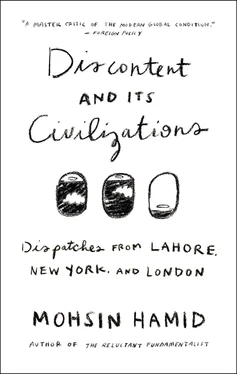What then is the status of the country’s majority? In Pakistan, there is no such thing. Punjab is the most populous province, but its roughly one hundred million people are divided by language, religious sect, outlook, and gender. Sunni Muslims represent Pakistan’s most populous faith, but it’s dangerous to be the wrong kind of Sunni. Sunnis are regularly killed for being open to the new ways of the West, or for adhering to the old traditions of the Indian subcontinent, for being liberal, for being mystical, for being in politics, the army or the police, or for simply being in the wrong place at the wrong time.
At the heart of Pakistan’s troubles is the celebration of the militant. Whether fighting in Afghanistan, or Kashmir, or at home, this deadly figure has been elevated to heroic status: willing to make the ultimate sacrifice, able to win the ultimate victory, selfless, noble. Yet as tens of thousands of Pakistanis die at the hands of such heroes, as tens of millions of Pakistanis go about their lives in daily fear of them, a recalibration is being demanded. The need of the hour, of the year, of the generation, is peace.
Pakistan is in the grips of militancy because of its fraught relationship with India, with which it has fought three wars and innumerable skirmishes since the countries separated in 1947. Militants were cultivated as an equalizer, to make Pakistan safer against a much larger foe. But they have done the opposite, killing Pakistanis at home and increasing the likelihood of catastrophic conflicts abroad.
Normalizing relations with India could help starve Pakistani militancy of oxygen. So it is significant that the prospects for peace between the two nuclear-armed countries look better than they have in some time.
India and Pakistan share a lengthy land border, but they might as well be on separate continents, so limited is their trade with each other and the commingling of their people. Visas, traditionally hard to get, restricted to specific cities and burdened with onerous requirements to report to the local police, are becoming more flexible for business travelers and older citizens. Trade is also picking up. A pulp manufacturer in Pakistani Punjab, for example, told me he had identified a paper mill in Indian Punjab that could purchase his factory’s entire output.
These openings could be the first cracks in a dam that holds back a flood of interaction. Whenever I go to New Delhi, many I meet are eager to visit Lahore. Home to roughly a combined 25 million people, the cities are not much more than half an hour apart by plane, and yet they are linked by only two flights a week.
Cultural connections are increasing, too. Indian films dominate at Pakistani cinemas, and Indian songs play at Pakistani weddings. Now Pakistanis are making inroads in the opposite direction. Pakistani actors have appeared as Bollywood leads and on Indian reality TV. Pakistani contemporary art is being snapped up by Indian buyers. And New Delhi is the publishing center for the current crop of Pakistani English-language fiction.
A major constraint the two countries have faced in normalizing relations has been the power of security hawks on both sides, and especially in Pakistan. But even in this domain we might be seeing an improvement. The new official doctrine of the Pakistani army for the first time identifies internal militants, rather than India, as the country’s number-one threat. And Pakistan has just completed an unprecedented five years under a single elected government. This year, it will be holding elections in which the largest parties all agree that peace with India is essential.
Peace with India, or, rather, increasingly normal neighborly relations, offers the best chance for Pakistan to succeed in dismantling its cult of militancy. Pakistan’s extremists, of course, understand this, and so we can expect to see, as we have in the past, attempts to scupper progress through cross-border violence. They will try to goad India into retaliating and thereby giving them what serves them best: a state of frozen, impermeable hostility.
They may well succeed. For there is a disturbing rise of hyperbolic nationalism among India’s prickly emerging middle class, and the Indian media is quick to stoke the fires. The explosion of popular rage in India after a recent military exchange, in which soldiers on both sides of the border were killed, is an indicator of the danger.
So it is important now to prepare the public in both countries for an extremist outrage, which may well originate in Pakistan, and for the self-defeating calls for an extreme response, which are likely to be heard in India. Such confrontations have always derailed peace in the past. They must not be allowed to do so again. In the tricky months ahead, as India and Pakistan reconnect after decades of virtual embargo, those of us who believe in peace should regard extremist provocations not as barriers to our success but, perversely, as signs that we are succeeding.
(2013)
US DRONES OPERATED by the CIA first struck in Pakistan in July 2004. According to the London-based Bureau of Investigative Journalism (TBIJ), there have now been a total of 367 such strikes. These have reportedly killed between 2,541 and 3,586 people in Pakistan’s Federally Administered Tribal Areas (FATA), the seven regions including North Waziristan and South Waziristan that border Afghanistan. The tribes on either side of the border were officially cut in two when the Durand Line between the countries was established in 1893, but in practice the border is porous. Of the 3.5 million people who live in FATA, most are Pashtuns, a group of tribes that claim common ancestry, divided into many subtribes and clans.
The frequency of US drone strikes in Pakistan has been strongly linked to US troop levels in Afghanistan. During the four and a half years that the drone campaign was conducted by President Bush, the American contingent in Afghanistan was typically 20,000 to 30,000 troops. Fifty-two drone strikes on Pakistan were conducted in this period. President Obama ordered a vastly intensified counterinsurgency operation that saw US troop levels in Afghanistan rise to 100,000. Under Obama’s command, drone strikes on Pakistan likewise spiked to 315.
This link has been maintained since forces began withdrawing from Afghanistan in 2011. US drone strikes in Pakistan began diminishing that year as well: from a peak of 128 in 2010, they fell to 75 in 2011 and 48 in 2012. Nonetheless, the tempo of US drone strikes in Pakistan today remains considerably higher than it was under President Bush.
Living Under Drones , an excellent report by researchers at the Stanford and NYU law schools on the impact of US drone strikes in Pakistan, fails to give prominence to this declining number of drone attacks. (It was published last September, before full-year data for 2012 became available.) But it remains a vital and important document. The US government provides little public information on its drone campaign. The Pakistani government restricts journalist access to the tribal areas. Citizens of both countries should welcome the report’s attempt to provide a rigorous accounting.
—
IF THERE IS any misconception that the drone strikes are primarily counterterrorist in nature, aimed at key leaders of international terror networks, this can be dispensed with. The report from Stanford and NYU highlights research separately conducted by Reuters and by the New America Foundation that comes to similar conclusions: the elimination of “high-value” targets — al-Qaeda or “militant” leaders — has been exceedingly rare, fewer than fifty people, or about 2 percent of all drone deaths. Rather, “low-level insurgents” have been the main targets of drones. The US drone campaign in Pakistan is thus largely a counterinsurgency operation, targeting men presumed to be intent on fighting US forces across the border in Afghanistan.
Читать дальше












